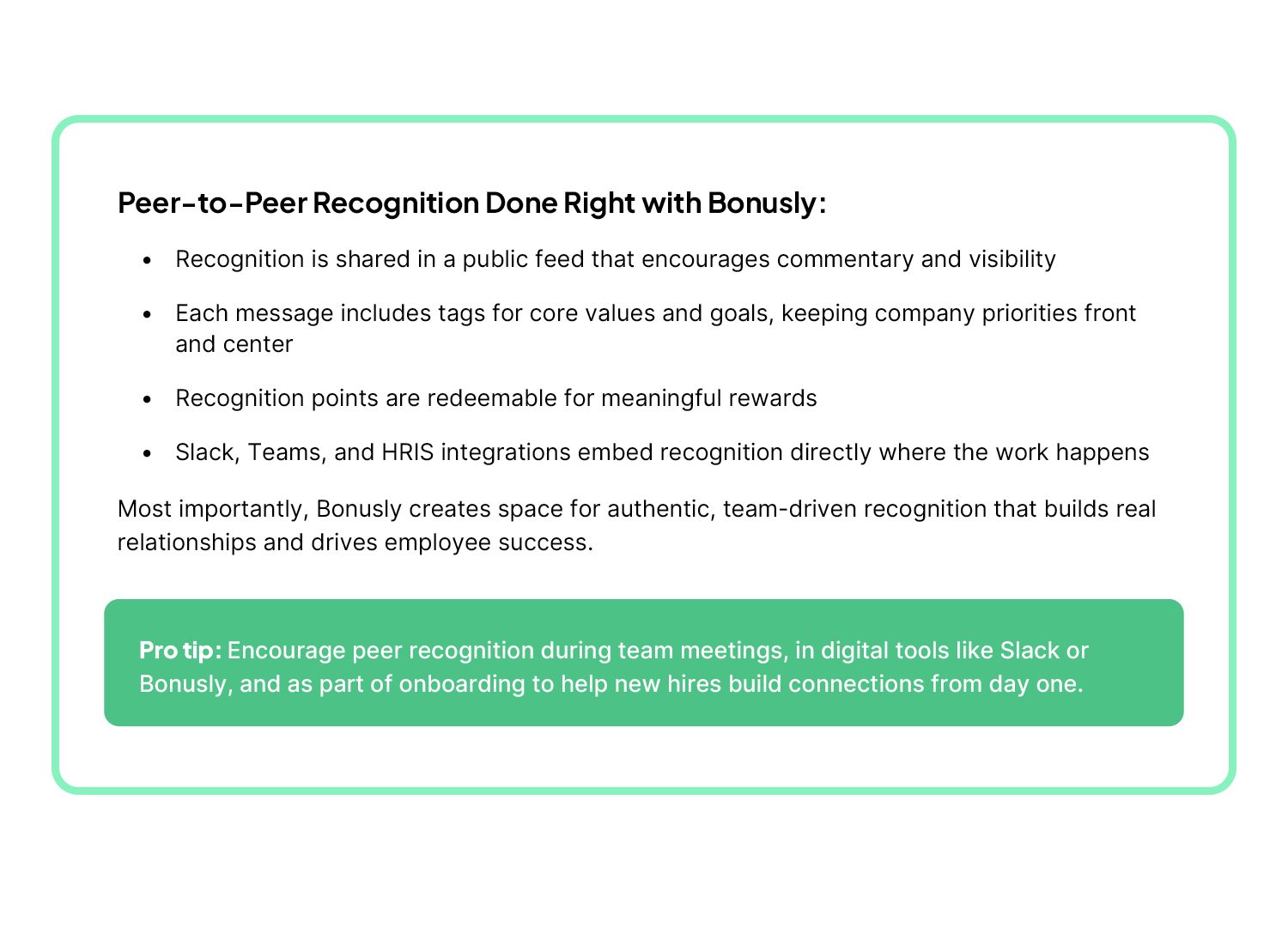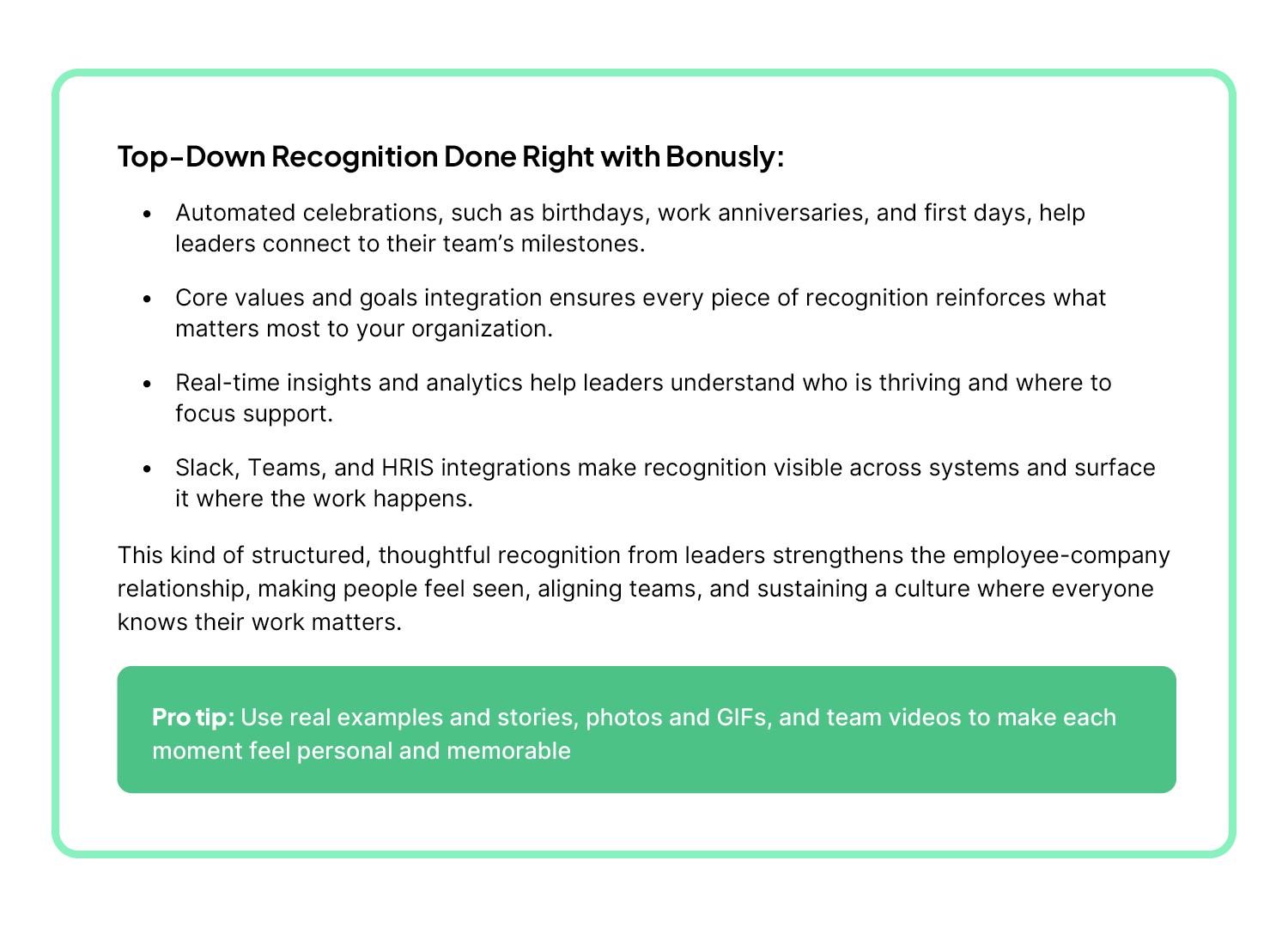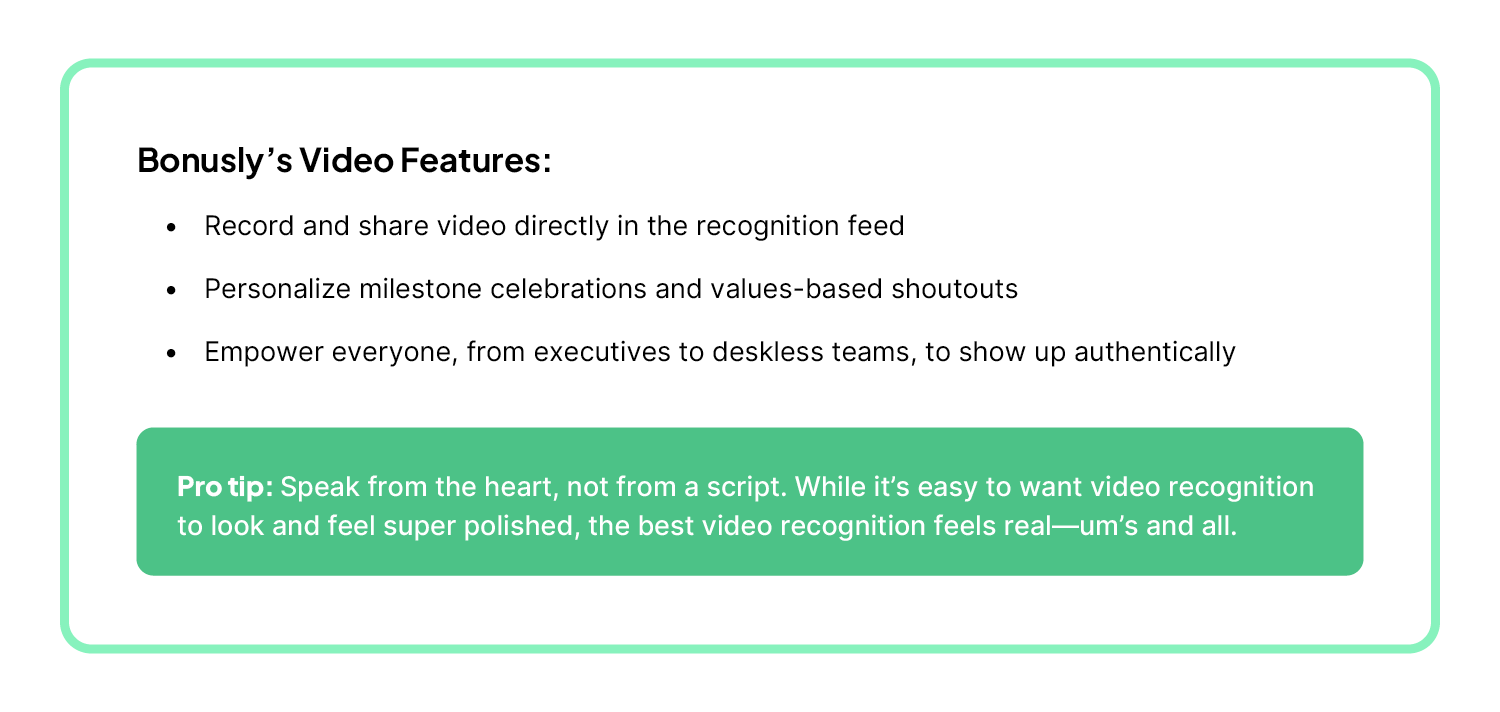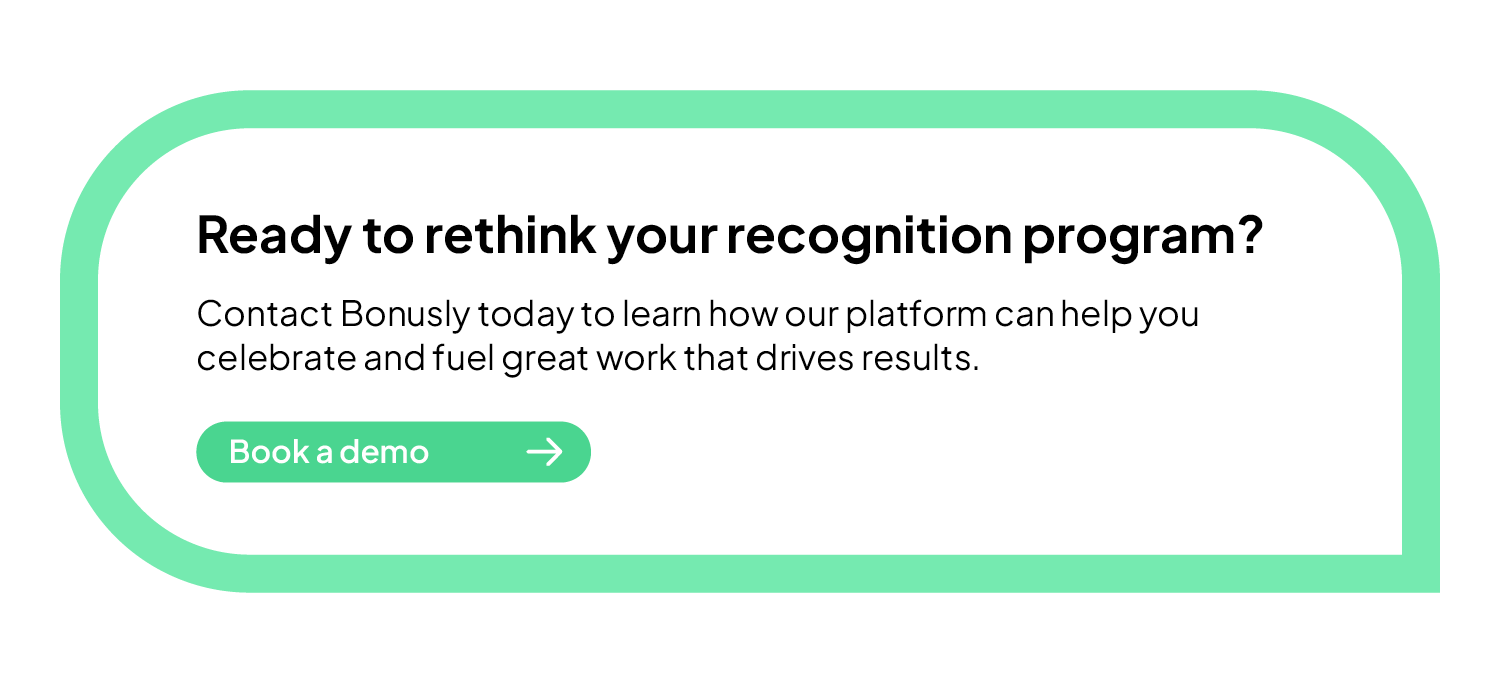Are you ready to implement effective recognition at your organization? Then you’ve come to the right place.

Chapter 1: Recognition
Are you ready to implement effective recognition at your organization? Then you’ve come to the right place. Recognition done right celebrates what's going well in the workplace and signals where and how employees can grow. Best-in-class organizations view recognition as a culture and performance lever, influencing how people connect, collaborate, and perform. (You're doing it wrong if you think of your recognition program as a checkbox or perk.)
In other words, the most effective recognition programs go beyond transactional praise; they're transformational by design.
This toolkit outlines how to build a best-in-class recognition program that includes peer-to-peer recognition, top-down celebrations, and human-centered video. Use this guide to align your program with today's employee expectations and set it up for long-term success.

Why recognition programs matter
An excellent recognition program doesn't just feel good—it does good. Recognition done right strengthens your culture and builds the relationships that drive engagement, retention, and performance. It brings visibility to great work and opens the door to meaningful growth.
Meeting employee demand
Purpose, autonomy, and alignment are the levers that today's workforce, especially Millennials and Gen Z, is pulling for. Recognition meets those needs in a daily and tangible way.
Employees want helpful feedback from their managers, to feel valued by their employer, and connected to their teammates. A well-built recognition program enhances those relationships, driving purpose and fueling better work.
The case for richer data
Recognition is also a source of invaluable data. The more frequent, meaningful, and visible your recognition program is, the more insight it provides into how your company works daily.
Every recognition moment tells a story: who’s going above and beyond, which values are being lived out, which teams are collaborating, and where leadership is making an impact. With the right platform, those stories become measurable.
That’s a goldmine for making more thoughtful and strategic decisions. Recognition data can inform:
- Culture alignment: Track which values are surfacing—and where gaps may exist.
- Talent development: Identify top-performers, unsung heroes, and people who work well cross-functionally
- Org health: Spot “recognition deserts” before they become retention risks.
- Manager effectiveness: See who’s leading with empathy and trust.
In other words, recognition creates a daily feedback loop and a strategic dashboard. The more your employees use it, the richer the insights.
How to think about ROI
Recognition is a business strategy. Organizations that prioritize meaningful, consistent recognition unlock powerful returns across every area of the employee experience. From boosting performance and productivity to reducing turnover and fostering deeper engagement, recognition is one of the most cost-effective and high-impact tools a company has.
When you recognize people frequently and meaningfully, you’re building a culture of motivation, connection, and high performance. And when that culture is embedded into daily operations, the impact compounds, delivering a return on investment (ROI) daily.
Let’s break down the numbers behind why recognition is worth the investment.
Employee Experience
The numbers:
• Employees who feel appreciated are 18% more productive
• A culture of recognition improves workplace relationships by 87%
What success looks like:
• Employee engagement scores increase quarter over quarter
• Increased Employee Net Promoter (eNPS) scores
What success sounds like:
“I feel like the work I do actually matters here.”
Employee Impact
The numbers:
• Organizations with high engagement see 147% better financial performance
• Recognition reinforces key behaviors that drive 23% higher profits
What success looks like:
• Amount of recognition tied to core values
• Goals met per team
• Output metrics reach or exceed goals (performance ratings, projects completed, revenue)
What success sounds like:
“The behaviors we want to see are the ones we’re recognizing—and those behaviors are driving results.”Employee Retention
The numbers:
• Feeling valued leads to loyalty—recognition reduces turnover by 32%
• When recognition is missing, employees are 2x more likely to quit
What success looks like:
• Turnover reduction within key departments
• Increase in average tenue
What success sounds like:
“I’ve stayed here because I feel valued—and that’s not something I take for granted.”

Building a best-in-class recognition program
Before discussing tactics, let’s define what "best-in-class" truly means. A strong recognition program scales with your culture, adapts to different work styles, and includes everyone, whether behind a desk, out in the field, or in the office.
Recognition program features
Good
Recognition happens occasionally, mostly from managers or during all-hands meetings.
Better
Recognition is structured with a platform that enables both peer-to-peer and top-down recognition, aligned with values.
Best
Recognition is embedded into daily culture, visible across teams, and includes dynamic media like video. It's measured consistently and championed by leadership. It celebrates great work and motivates employees to grow.
Launching and building your program
We’ve explained the “why.” Now it’s time to focus on the how. Building a recognition program that truly sticks requires intention and consistency. These foundational elements will help you launch and sustain a program that engages your people and grows with your organization.
Key Program Elements
- Define the purpose. Start with the "why." Are you trying to increase engagement, reinforce values, or boost retention? Align your goals with business outcomes.
- Design with inclusivity in mind. Ensure all remote, in-office, and deskless employees can give and receive recognition. Make participation equitable and accessible.
- Tie recognition to values. Recognition is most impactful when it reinforces the behaviors and outcomes that matter. Use company values as hashtags or categories.
- Create the right rhythm. Encourage daily or weekly recognition habits. Research indicates that the most effective forms of recognition occur at least once a week.
- Train and empower all participants. Equip everyone with tips and templates to provide effective recognition.
- Measure, learn, and iterate. Use data to track participation, sentiment, and impact. Share wins and evolve your approach over time.
Launching a recognition program is just the beginning. The real challenge is sustaining momentum and building habits that last. With these key elements in mind, here's a structured approach you can follow from implementation to steady-state use:
Phase 1: Planning (4-6 Weeks Before Launch)
- Define program goals and success metrics
- Select your recognition platform and tools
- Develop your program guidelines and policies
- Create communication and training materials
- Configure platform settings and integrations
Phase 2: Launch (1-2 Weeks)
- Announce the program through multiple channels
- Conduct training sessions for all employees
- Provide quick-start guides and FAQs
- Establish "recognition champions" in each department
- Set up a help desk for questions and troubleshooting
Phase 3: Adoption (First 90 Days)
- Run weekly participation challenges
- Highlight early adopters and success stories
- Share recognition trends in company communications
- Use analytics to uncover engagement or performance concerns
- Make adjustments based on initial feedback
Phase 4: Sustainability/Growth (Ongoing)
- Integrate recognition into regular meetings and workflows
- Refresh training materials quarterly
- Run periodic campaigns to boost engagement
- Review program data and share insights
- Iterate on program design based on data and feedback
Deep dive: peer-to-peer recognition
Peer-to-peer recognition democratizes appreciation and strengthens the bonds between coworkers. When employees regularly acknowledge each other's contributions, it fosters an ongoing feedback loop that motivates and promotes shared success. This form of recognition highlights the everyday actions that drive team wins.
Most importantly, peer-to-peer recognition fosters critical workplace relationships, promoting camaraderie and enhancing employee collaboration. It gives managers a deeper understanding of their teams' contributions and ties individual efforts to broader company goals, deepening the employee-company connection.

Deep dive: top-down recognition
Top-down recognition is the structural counterpart to peer-to-peer recognition. While peer appreciation fosters camaraderie and trust across teams, manager- and leader-led recognition helps set the tone for excellent work and reinforces alignment.
When leaders consistently recognize team members, they build trust, signal priorities, and amplify key behaviors. This kind of recognition is essential for motivating performance and fostering a sense of belonging.
It’s also a vital feedback mechanism. Top-down recognition provides managers with a clear view of their team’s strengths, areas for growth, and engagement levels. Done right, it becomes a system that supports visibility, alignment, and real-time coaching.

Raise the bar with video recognition
As the workplace becomes increasingly digital and distributed, the need for genuine human connection is more important than ever.
Video adds personality and depth to recognition, enhancing the message with face-to-face energy and empowering everyone to articulate gratitude with a personal touch. It's a powerful medium that builds stronger emotional engagement and deeper trust.

Other Considerations for Top Programs
Even the best recognition programs can fall short if you don’t have the right support and tools. As you evaluate or optimize your program, here are a few essential, but often overlooked, factors that make a big difference.
- A strategic partner and support team you can count on
Your recognition platform should be a true partner in your culture-building efforts. Bonusly’s Customer Success team is known for being invested in customer outcomes, with dedicated teams that help you launch and scale with confidence. The best support teams proactively guide you through setup and help you unlock more value over time. - Seamless integrations with the tools your team already uses
Recognition should meet your team where they are, whether that’s Slack, Microsoft Teams, or your HRIS. Bonusly offers best-in-class integrations with all major communication and HR systems, making it easy to recognize teammates in real-time. Integrations boost participation and make recognition feel like a natural part of the workday. - High adoption and visibility across the organization
Recognition only works if people actually use it. High adoption ensures a steady flow of recognition and provides rich data for understanding how teams work together. Bonusly’s intuitive, mobile-friendly platform drives the highest adoption rate in the industry, giving leaders full visibility into what’s working and who’s making it happen. When recognition is visible and consistent, it shapes culture and drives behavior.
Recognition as Part of an Integrated Strategy
Recognition programs are foundational to a well-rounded engagement strategy, but don't stand alone. Peer-to-peer and top-down recognition work best when integrated with other programs like awards, nominations, incentives, and manager tools.
Together, these programs form a complete employee success ecosystem:
- Recognition keeps people engaged and connected day-to-day
- Awards and incentives motivate high performance and impact
- Manager tools like 1:1s and feedback sessions support growth and development
→ Want more? Download our full playbook series to explore each layer of recognition strategy:
- Awards & Rewards
- Feedback & Growth
Implementing Recognition Done Right
Recognition is more than a feel-good initiative. It's the heartbeat of high-performing cultures. Building recognition into your daily operations through peer-to-peer shoutouts, top-down celebrations, and meaningful video messages strengthens the relationships that drive engagement, retention, and performance.
Start with recognition, and you'll transform your entire organization.
Other Considerations for Top Programs
Even the best recognition programs can fall short if you don’t have the right support and tools. As you evaluate or optimize your program, here are a few essential, but often overlooked, factors that make a big difference.
- A strategic partner and support team you can count on
Your recognition platform should be a true partner in your culture-building efforts. Bonusly’s Customer Success team is known for being invested in customer outcomes, with dedicated teams that help you launch and scale with confidence. The best support teams proactively guide you through setup and help you unlock more value over time. - Seamless integrations with the tools your team already uses
Recognition should meet your team where they are, whether that’s Slack, Microsoft Teams, or your HRIS. Bonusly offers best-in-class integrations with all major communication and HR systems, making it easy to recognize teammates in real-time. Integrations boost participation and make recognition feel like a natural part of the workday. - High adoption and visibility across the organization
Recognition only works if people actually use it. High adoption ensures a steady flow of recognition and provides rich data for understanding how teams work together. Bonusly’s intuitive, mobile-friendly platform drives the highest adoption rate in the industry, giving leaders full visibility into what’s working and who’s making it happen. When recognition is visible and consistent, it shapes culture and drives behavior.
Recognition as Part of an Integrated Strategy
Recognition programs are foundational to a well-rounded engagement strategy, but don't stand alone. Peer-to-peer and top-down recognition work best when integrated with other programs like awards, nominations, incentives, and manager tools.
Together, these programs form a complete employee success ecosystem:
- Recognition keeps people engaged and connected day-to-day
- Awards and incentives motivate high performance and impact
- Manager tools like 1:1s and feedback sessions support growth and development
→ Want more? Read our full playbook series to explore each layer of recognition strategy:
Implementing Recognition Done Right
Recognition is more than a feel-good initiative. It's the heartbeat of high-performing cultures. Building recognition into your daily operations through peer-to-peer shoutouts, top-down celebrations, and meaningful video messages strengthens the relationships that drive engagement, retention, and performance.
Start with recognition, and you'll transform your entire organization.




